Preliminary Concepts¶
A mesh (sometimes also called a grid), denoted by \(\mathcal{M}(\Omega)\), provides a discrete represenation of a geometric domain of interest, \(\Omega\), on which, the underlying mathematical model is evaluated. The mathematical model is typically defined by a system of governing Partial Differential Equations (PDEs) and associated boundary and initial conditions. The solution to the governing PDE predicts a physical process that occurs and evolves on \(\Omega\) over time. For example, consider the flow around an aircraft, turbulence modeling, blast wave propagation over complex terrains, or, heat transfer in contacting objects, to name a few. Evolving the mathematical model to predict such a physical process is typically done numerically, which requires discretizing the governing PDE by a numerical scheme, such as a Finite Difference (FD), Finite Volume (FV), or, the Finite Element Method (FEM), chief among them.

Fig. 3 Mesh discretization of a geometric domain: (a) Sample geometric domain, \(\Omega\). (b) Corresponding mesh of the domain, \(\mathcal{M}(\Omega)\). The nodes and cells of the mesh, depicted in red, correspond to the discrete locations where the unknown variables of the governing PDE are stored and evaluated.
Discretization of the governing PDE requires the domain to be approximated with a mesh. For example, Fig. 3 (a) depicts a geometric domain, \(\Omega\). The corresponding mesh, \(\mathcal{M}(\Omega)\), is illustrated in Fig. 3 (b). The mesh approximates the geometric domain, \(\Omega\), by a finite number of simple geometric entities, such as nodes and cells, depicted in red in Fig. 3 (b). These geometric entities comprising the mesh define the discrete locations, in space and time, at which the unknown variables, i.e., the degrees of freedom of the governing PDE, are evaluated, by the numerical scheme being employed.
There are a variety of different Mesh Types one can choose from. The type of mesh employed depends on the choice of the underlying numerical discretization scheme. For example, a finite difference scheme typically requires a Structured Mesh. However, the finite volume and finite element methods may be implemented for both Structured Mesh and Unstructured Mesh types. In contrast, meshless or mesh-free methods, such as Smoothed Particle Hydrodynamics (SPH), discretize the governing PDE over a set of particles or nodes, using a Particle Mesh representation.